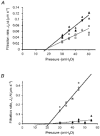The chronic effect of vascular endothelial growth factor on individually perfused frog mesenteric microvessels
- PMID: 9782172
- PMCID: PMC2231266
- DOI: 10.1111/j.1469-7793.1998.225by.x
The chronic effect of vascular endothelial growth factor on individually perfused frog mesenteric microvessels
Abstract
1. Hydraulic conductivity (Lp) of the wall of perfused microvessels has previously been shown to be chronically increased 24 h after a 10 min perfusion with vascular endothelial growth factor (VEGF). In order to investigate this further, Lp and the effective oncotic pressure difference (f3DeltaPi) acting across the vessel walls was measured before exposure to VEGF and 24 h later after the mesentery had been replaced in the abdominal cavity. 2. Acute 10 min perfusion with VEGF did not chronically change f3DeltaPi despite chronically increasing Lp 6.8 +/- 1.2-fold. This suggests that pathways formed 24 h after perfusion with VEGF which increase hydraulic conductivity of the capillary walls have the same reflection coefficient as those present before VEGF. 3. Acute 10 min perfusion with VEGF significantly increased the diameter of vessels after 24 h by 48 +/- 13%. To determine whether this was due to changes in the compliance of the vessel wall, the distensibility of microvessels was measured before and 24 h after perfusion with VEGF. The distensibility was increased 45 +/- 15% by VEGF but this was not great enough to account for the increase in diameter. 4. The chronic increase in Lp could be attenuated by inhibition of nitric oxide synthase with L-NAME. In addition, the chronic increase in permeability was correlated with the acute response to VEGF (r = 0.71, P < 0.01) suggesting that the acute and chronic changes may be related. 5. These results show that VEGF chronically increases Lp without affecting the oncotic reflection coefficient. This may be due to reduced pore path length, or increased small pore numbers, which are properties of fenestrated capillaries. They also show that VEGF increases microvascular distensibility and diameter.
Figures

 ), then with 1 n
), then with 1 n , are the peak values recorded during perfusion with VEGF), then 24 h later perfused again with BSA (day 2,
, are the peak values recorded during perfusion with VEGF), then 24 h later perfused again with BSA (day 2,  ). **P < 0.01 compared with baseline on day 1.
). **P < 0.01 compared with baseline on day 1.


 ) and 24 h after perfusion with VEGF (
) and 24 h after perfusion with VEGF ( ). *P < 0.05 and **P < 0.01 compared with day 1.
). *P < 0.05 and **P < 0.01 compared with day 1.


Similar articles
-
Vascular endothelial growth factor increases Rana vascular permeability and compliance by different signalling pathways.J Physiol. 2001 May 15;533(Pt 1):263-72. doi: 10.1111/j.1469-7793.2001.0263b.x. J Physiol. 2001. PMID: 11351033 Free PMC article.
-
Vascular endothelial growth factor increases hydraulic conductivity of isolated perfused microvessels.Am J Physiol. 1996 Dec;271(6 Pt 2):H2520-8. doi: 10.1152/ajpheart.1996.271.6.H2520. Am J Physiol. 1996. PMID: 8997313
-
Effect of VEGF on retinal microvascular endothelial hydraulic conductivity: the role of NO.Invest Ophthalmol Vis Sci. 2000 Dec;41(13):4256-61. Invest Ophthalmol Vis Sci. 2000. PMID: 11095623
-
VEGF and ATP act by different mechanisms to increase microvascular permeability and endothelial [Ca(2+)](i).Am J Physiol Heart Circ Physiol. 2000 Oct;279(4):H1625-34. doi: 10.1152/ajpheart.2000.279.4.H1625. Am J Physiol Heart Circ Physiol. 2000. PMID: 11009449
-
In vivo mechanisms of vascular endothelial growth factor-mediated increased hydraulic conductivity of Rana capillaries.J Physiol. 2001 Jul 15;534(Pt. 2):479-88. doi: 10.1111/j.1469-7793.2001.00479.x. J Physiol. 2001. PMID: 11454965 Free PMC article.
Cited by
-
Fluid and protein exchange in microvascular networks: Importance of modelling heterogeneity in geometrical and biophysical properties.J Physiol. 2021 Oct;599(20):4597-4624. doi: 10.1113/JP281841. Epub 2021 Oct 10. J Physiol. 2021. PMID: 34387386 Free PMC article.
-
Measurement of angiogenic phenotype by use of two-dimensional mesenteric angiogenesis assay.Methods Mol Biol. 2009;467:251-70. doi: 10.1007/978-1-59745-241-0_15. Methods Mol Biol. 2009. PMID: 19301676 Free PMC article.
-
[Early antiexudative response--OCT monitoring after intravitreal bevacizumab injection].Ophthalmologe. 2006 Jun;103(6):476-83. doi: 10.1007/s00347-006-1356-1. Ophthalmologe. 2006. PMID: 16763864 Review. German.
-
Measurement of hydraulic conductivity of single perfused Rana mesenteric microvessels between periods of controlled shear stress.J Physiol. 2002 Sep 15;543(Pt 3):947-57. doi: 10.1113/jphysiol.2002.026369. J Physiol. 2002. PMID: 12231650 Free PMC article.
-
Loss of the endothelial glycocalyx links albuminuria and vascular dysfunction.J Am Soc Nephrol. 2012 Aug;23(8):1339-50. doi: 10.1681/ASN.2012010017. Epub 2012 Jul 12. J Am Soc Nephrol. 2012. PMID: 22797190 Free PMC article.
References
-
- Ahmad Z, Michel C. Effects of nitric oxide synthase inhibition on the permeability of rat mesenteric venules. Journal of Vascular Research. 1998 (in the Press)
-
- Bates DO. Chronically increased hydraulic conductivity (Lp) by vascular endothelial growth factor (VEGF) is attenuated by inhibition of nitric oxide synthase. Journal of Vascular Research. 1998a (in the Press)
-
- Bates DO. Vascular endothelial growth factor (VEGF) chronically increases microvascular hydraulic conductivity (Lp) without affecting oncotic reflection coefficient (σ) FASEB Journal. 1998b;12:A22.
-
- Bates DO, Curry FE. Vascular endothelial growth factor increases hydraulic conductivity of isolated perfused microvessels. American Journal of Physiology. 1996;271:H2520–2528. - PubMed
-
- Bates DO, Curry FE. Vascular endothelial growth factor increases microvascular permeability via a Ca(2+)-dependent pathway. American Journal of Physiology. 1997;273:H687–694. - PubMed
Publication types
MeSH terms
Substances
Grants and funding
LinkOut - more resources
Full Text Sources

